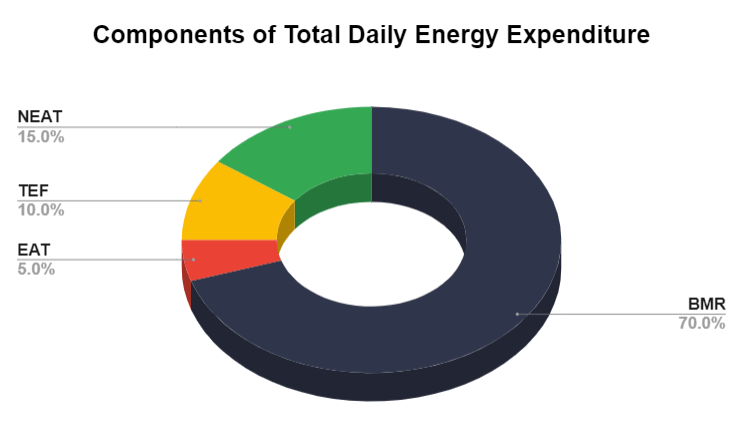The Best Way to Find Your Maintenance Calorie Intake

Knowing how many calories you need to eat to maintain your current body weight is helpful when trying to lose or gain weight. When you know your maintenance calorie intake, you can make the right adjustments to reach your goal.
First, here are some terms and things to know that will help you gain a better understanding of energy expenditure and energy balance.
TDEE (Total Daily Energy Expenditure) = This is your maintenance calorie intake. It’s the total number calories you burn per day, including physical activity. TDEE is made up of your BMR, NEAT, EAT, and TEF. If you take in the same number of calories you burn, you maintain your current body weight.
BMR (Basal Metabolic Rate): The number of calories your body burns carrying out nothing but the basic, life-sustaining functions. This is the number of calories you’d burn if you stayed in bed all day and did absolutely nothing. BMR makes up about 70% of your TDEE.
NEAT (Non-Exercise Activity Thermogenesis): The number of calories your body burns during every day movement outside of exercise, like fidgeting, blinking, doing house chores, walking to your car, etc. NEAT can vary a lot person to person, but on average it makes up about 15% of your TDEE.
TEF (Thermic Effect of Food) : The number of calories your body burns digesting and absorbing food. Protein has a TEF of about 20-30%, carbohydrates have a TEF of about 5-10%, and fat has a TEF of about 0-3%. TEF makes up about 10% of your TDEE.
EAT (Exercise Activity Thermogenesis): The number of calories your body burns during exercise. EAT makes up about 5% of your TDEE.
Energy Deficit: Being in an energy deficit means you’re taking in less calories than you’re burning. This results in weight loss. You’ll also see this referred to as a calorie deficit. A calorie is a unit of energy
Energy Surplus: Being in an energy surplus means you’re taking in more calories than you’re burning. This results in weight gain. You’ll also see this referred to as a calorie surplus.
Calories In 1 Pound of Fat: There are approximately 3,500 calories in 1 pound of fat. If you want to lose about 1 pound per week, you can create an energy deficit of 500 calories through a combination of increasing activity level and decreasing your calorie intake (- 500 calories x 7 days in a week = – 3,500 calories in a week = lose 1 pound of fat). Human physiology is dynamic. It’s always changing. It can be messy, complex, and at times, even unpredictable. So these numbers are not 100% accurate, but they’re accurate enough to allow us to make the proper adjustments to our diet over time to lose weight, gain weight, or maintain our weight.

Online calorie calculators can be a good start, but they’re just estimates. These estimates can give you a good starting point, sometimes. They can be very accurate for some people, and they can be off by quite a lot for others. After using a calorie calculator, or using a few and taking the average, you need to consistently track your body weight and calorie intake to determine what your maintenance calorie intake truly is.
If you don’t want to use an online calorie calculator, another option is to continue eating out how you are, track your calorie intake each day, and weigh yourself at least a few days a week, ideally daily. I recommend tracking your calorie intake and body weight daily so you can get the weekly averages. Do this for 2-3 weeks, and you’ll have a much better idea what your maintenance calorie intake really is.
If your body weight stays the same, you’re at maintenance. If you gain weight, you’re in an energy surplus. If you lose weight, you’re in an energy deficit. From here, you can keep your calorie intake the same, increase it, or decrease it, depending on your goal.
It’s simple, but here are three common mistakes I see when attempting to find maintenance.
- Overestimating activity level when using an online calculator. This will overestimate your TDEE.
- Not being consistent enough with tracking body weight and calorie intake.
- Not accurately tracking calories. Entering the wrong foods or amounts, and not accounting for snacks, coffee creamer, high-calorie condiments and sauces, oils, etc.
To break down finding maintenance into three simple steps…
Step 1: Use an online calorie calculator to find a calorie intake to try out, or keep eating how you are.
Step 2: Weigh your food, accurately track your calorie intake, and weigh yourself every day to get the weekly averages.
Step 3: Look at how your body weight changes in response to your calorie intake after 2-3 weeks, and adjust your calorie intake if needed depending on your goal.
This is the best way to find your maintenance calorie intake since all other methods involving equations are rough estimates. Nothing is more helpful than seeing how your body weight and body composition responds to a certain number of calories.
